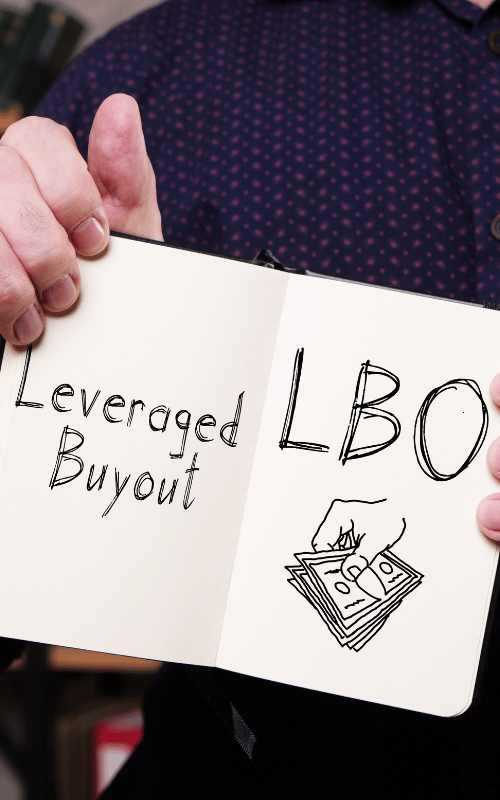Le LBO, ou « Leveraged Buy Out », est un outil particulièrement efficace et utilisé pour acquérir une société. Il permet en effet de réaliser une acquisition avec un apport en capital minimal par rapport au montant de l’acquisition, ceci en utilisant au maximum la dette. Cela permet de maximiser le rendement des capitaux propres investis : c’est « l’effet de levier financier ».
L’opération consiste pour l’acquéreur, qu’il soit un groupe ou un individu, à créer une société « holding » qui rachètera les titres de la société cible. La holding va ensuite souscrire une dette auprès d’un ou plusieurs établissements financiers, amortissable souvent sur 7 ans, appelée dette senior. Celle-ci peut éventuellement être complétée par une dette bancaire remboursable « in fine » et/ou une émission d’obligations ou d’autres titres hybrides.
Enfin, il peut être nécessaire de compléter le capital amené par l’acquéreur à la holding par un apport en fonds propres d’investisseurs extérieurs, tels que des fonds d’investissement ou business angels, désignés comme des « sponsors ». Si l’opération de LBO peut se réaliser uniquement grâce à l’apport en fonds propres des repreneurs et/ou des managers et la dette bancaire, le LBO est appelé « sponsorless ».
La dette contractée par la holding sera ensuite remboursée à partir des flux de trésorerie générés par la société cible, via la distribution de dividendes à la holding, sa maison mère.
Ce montage permet ainsi d’acquérir une société en apportant un minimum de capitaux et l’effet de levier permettra d’augmenter le retour des capitaux investis.
Un acquéreur souhaite acquérir une société valorisée 10 M€, qui génère 1,4 M€ de résultat net par an. Il dispose de 3 M€. Il crée une société holding qui achètera 100% de la cible et apporte en capital ses 3 M€ à la holding. La holding souscrit 7 M€ de dette senior sur 7 ans, à un taux annuel par exemple de 5%, ce qui correspond à des échéances annuelles de 1,2 M€ environ. Chaque année, la société cible va verser 1,2 M€ de dividendes à la holding pour que celle-ci rembourse ses emprunts. A l’issue des 7 ans, la holding aura totalement remboursé sa dette. En supposant de façon très prudente que la valorisation de la société cible n’a pas évolué pendant cette période, l’acquéreur détiendra donc 100% d’une société holding, qui possède 100% d’une société cible valorisée 10 M€ et n’a plus de dettes. La holding vaudra donc 10 M€. L’acquéreur aura investi 3 M€ et détient les titres d’une holding qui vaut maintenant 10 M€. Il a donc multiplié la valeur de son investissement par 3,3, juste par le mécanisme de l’effet de levier.

C’est un montage particulièrement adapté à la reprise d’une société par ses managers, opération de LBO alors appelée LMBO (Leveraged Management Buy out), ou par un manager extérieur en MBI (Management Buy In), si bien évidement la société est suffisamment rentable.
Notons au passage qu’une vertu du LBO est d’obliger à mettre en place dans l’entreprise (si ce n’est déjà fait) des outils de gestion, de reporting et de suivi de trésorerie, afin de piloter le respect du business plan et du plan de remboursement de la dette.
La création de la holding d’acquisition permet de mettre enœuvre 3 autres types d’effet de levier :
Avec une holding et des associés qui restent minoritaires au capital, un acquéreur peut contrôler une cible avec un apport qui ne lui permettrait pas d’être majoritaire en rachetant directement la cible, mécanisme qui peut être réalisé « en cascade ».
Ainsi, dans le cas où l’acquéreur dirigeant n’a pas un apport en capital suffisant pour être majoritaire au capital de la holding de reprise (Holding 1), au lieu d’investir en direct dans celle-ci, il peut investir à travers sa propre holding (« Holding 2 ») qu’il créera en faisant entrer des investisseurs minoritaires en capital dans la Holding 2.
Par exemple, en reprenant le cas ci-dessus, l’acquéreur ne dispose que de 1 M€ (au lieu des 3 M€ nécessaires) pour racheter la cible valorisée 10 M€. Il trouve des investisseurs prêts à investir 1,5 M€ dans le capital de la Holding 1 de reprise. S’il investissait lui directement au niveau de la Holding 1, il serait minoritaire avec seulement 33% du capital.
Il crée donc une Holding 2 avec son apport de 1 M€ et fait entrer des investisseurs minoritaires (en love money par exemple) pour 0,6 M€ au capital de la Holding 2. Il détient ainsi 62,5% de la Holding 2, la préside et contrôle celle-ci. La Holding 2 investit son capital de 1,6 M€ dans la Holding1 de reprise, et 1,4 M€ sont apportés par des investisseurs dans la Holding1. La Holding 2, représentée par l’acquéreur, est majoritaire avec 53,3% du capital de la Holding 1, et la contrôle. Enfin, la holding 1, dotée des 3 M€ de capital nécessaire, rachète la cible selon le montage exposé ci-avant.
Ce montage « en cascade » permet ainsi à l’acquéreur de contrôler la cible alors qu’il n’en détient indirectement que 33,3% (62,5% x 53,3%) et n’a investi que 1 M€ sur les 3 M€ requis en capital.
En intégration fiscale, le déficit fiscal de la holding (sur les frais financiers) vient diminuer l’IS du groupe fiscal (holding + cible).
La participation des principaux cadres au capital et, le cas échéant, leur intéressement à la plus-value du partenaire financier sont des facteurs de motivation et de dynamisme des entreprises reprises en LBO.
Dans ce cas, des « management package » (« MANPACK ») sont mis en place et constituent des mécanismes particulièrement attractifs pour les managers, leur permettant souvent de multiplier leur investissement de manière très significative.
La possibilité d’acquérir une société en LBO dépend en effet de plusieurs facteurs :
Notons en outre que le durcissement actuel des conditions de prêts par les banques et l’augmentation des taux d’intérêts que l’on constate depuis 2022 est en train de limiter fortement la part de la dette pouvant être utilisée pour le financement d’une acquisition, quand bien même la rentabilité des sociétés n’est pas nécessairement impactée. Ces facteurs sont ainsi en train de faire abandonner certains projets d’acquisition, ou de pousser à la baisse les valorisations des sociétés.
La structuration d’une opération de LBO peut être complexe et doit être adaptée à la cible, au projet de l’acquéreur et à sa stratégie financière, ainsi qu’aux conditions de marché.
Elle nécessite d’abord de disposer d’une analyse financière fine, passée et future, de la cible, ainsi que d’un business plan solide. MBA Capital analyse ces éléments et les met à l’épreuve : cohérence des chiffres, crédibilité pour la communauté financière, faisabilité du montage, valorisation de la cible ou validation de celle-ci.
MBA Capital va ensuite concevoir le montage idoine qui permet d’optimiser tous les paramètres financiers, tout en répondant aux objectifs de l’acquéreur, notamment en termes de degré de contrôle de la structure. L’objectif en effet est de maximiser le recours aux financements les moins chers (dette bancaire senior) et calibrer le recours aux autres outils de financement : dette mezzanine, obligations, obligations convertibles, obligations avec BSA, actions gratuites, actions de préférence, etc. afin de minimiser, en principe, l’apport nécessaire en capital par des investisseurs extérieurs (financement le plus cher), tout ceci en fonction des caractéristiques de l’opération, des contraintes juridiques et financières, et des données de marché.
Ensuite, il conviendra d’établir un dossier de présentation précis de l’opération et du montage, à destination des différents financeurs qui seront sollicités. Ces financeurs devront être sélectionnés en fonction de leur adaptation au projet, et aux desiderata de l’acquéreur.
Une étape importante où l’intervention de MBA Capital est aussi particulièrement utile est la négociation avec ces financeurs banques et investisseurs, afin d’optimiser les termes des contrats (covenants des contrats de prêts, pacte d’associés, contrats d’OC, etc.).
MBA Capital accompagne les repreneurs, qu’ils soient groupes ou managers dans toutes ces étapes qui peuvent être complexes, dans le seul intérêt des porteurs du projet de LBO, et en toute indépendance vis-à-vis des financeurs, bancaires ou autres.
MBA Capital Bordeaux
Mis en ligne le 21 juillet 2023

Pour recevoir les dernières informations de MBA Capital, inscrivez-vous à la newsletter !